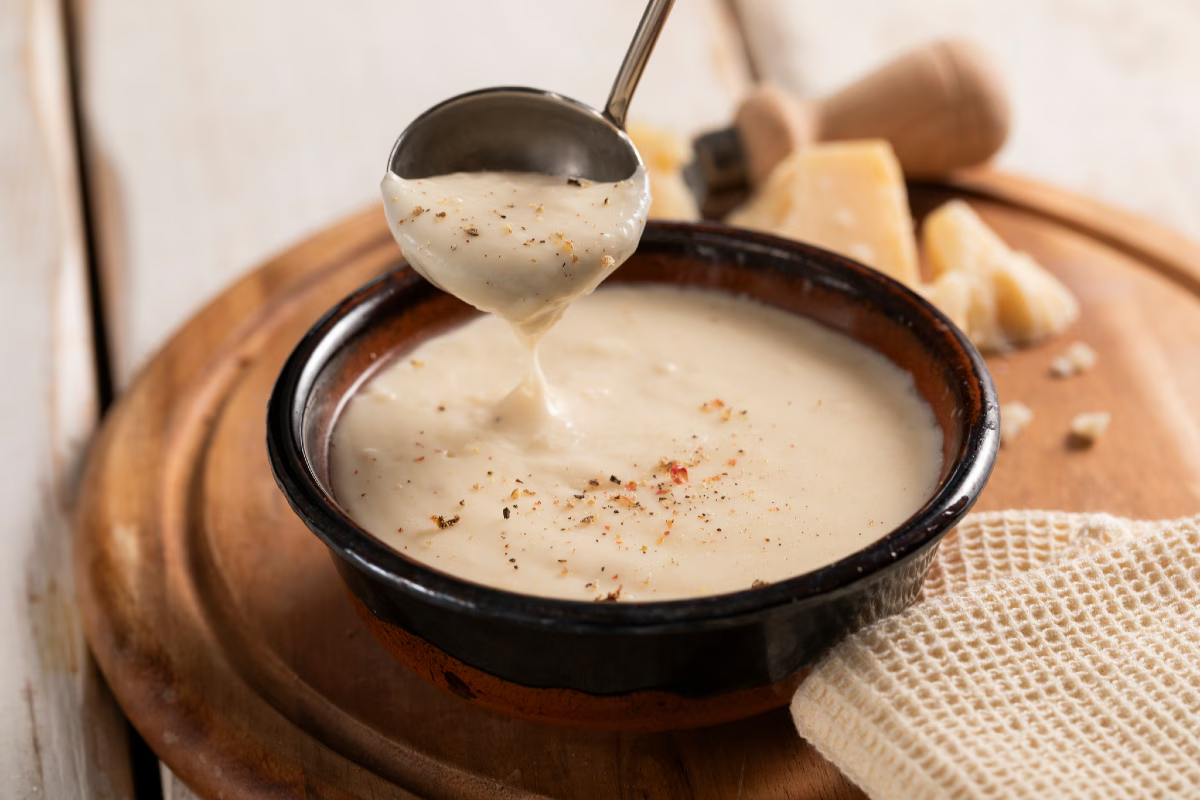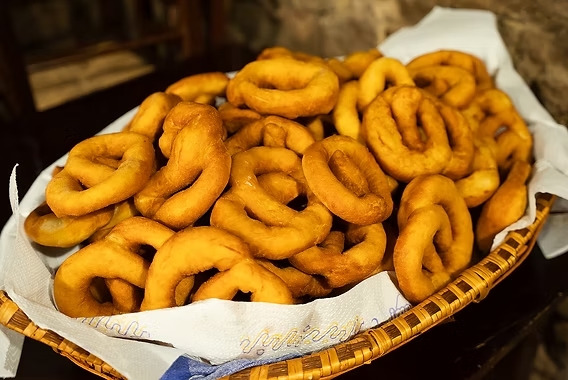Introduction
In the world of Italian cuisine, sauces hold a revered position, elevating simple ingredients into culinary masterpieces. Among these, the Parmigiano Cream Sauce stands out for its luscious texture, bold umami flavor, and versatility. Whether draped over freshly cooked pasta, stirred into risottos, or spooned over roasted vegetables, this sauce embodies the essence of comfort and sophistication. Its velvety consistency, achieved through a delicate balance of roux and cheese, ensures each bite is a harmonious blend of creaminess and depth. Crafted with authentic Parmigiano Reggiano DOP, this sauce exemplifies the richness and complexity that only genuine Italian cheese can impart.
At Love With Recipes, our goal is to bring you recipes that combine tradition with simplicity, ensuring that even home cooks with minimal experience can produce restaurant-quality dishes. This Parmigiano Cream Sauce is no exception—easy to prepare, yet impressive in taste and presentation. Its ingredients are few but of high quality, emphasizing the importance of selecting the best dairy and fresh pantry staples. Once mastered, this sauce can become a cornerstone of your culinary repertoire, adding elegance to everyday meals or serving as a luxurious component in special dining occasions.
Time
- Preparation Time: 10 minutes
- Cooking Time: 15 minutes
- Total Time: Approximately 25 minutes
Needed Equipment
- Medium-sized heavy-bottomed saucepan
- Small saucepan (for warming milk)
- Whisk
- Grater (for Parmigiano cheese)
- Measuring cups and spoons
- Cutting board and knife
- Heat-resistant spatula or spoon
- Ladle or spoon for serving
- A fine-mesh sieve (optional, for smoothness)
Tags
Italian, Cheese Sauce, Creamy, Easy, Comfort Food, Vegetarian, Sauces & Dips, Pasta, Rich, Velvety
Serving Size
This recipe yields approximately enough sauce to generously coat 400-500g (14-18 oz) of cooked pasta, serving four people comfortably. Adjustments can be made for larger quantities by scaling ingredients proportionally.
Difficulty Level
Intermediate—While the steps are straightforward, achieving the perfect velvety consistency requires attention to detail, especially during the roux preparation and gradual incorporation of milk and cheese.
Allergen Information
| Allergen | Present |
|---|---|
| Dairy | Yes (milk, butter, cheese) |
| Gluten | Yes (all-purpose flour) |
Dietary Preference
Vegetarian (contains dairy but no meat or fish)
Course
Sauce / Condiment
Cuisine
Italian
Ingredients
Ingredient Details
| Ingredient | Quantity | Description |
|---|---|---|
| Parmigiano Reggiano DOP | 200g (about 7 oz) | Freshly grated for optimal flavor and melting |
| Whole milk | 500g (about 2 cups) | Full-fat milk for richness |
| All-purpose flour (type 00 preferred) | 50g (about 1/3 cup) | Creates the roux, thickening agent |
| Butter | 50g (about 4 tablespoons) | Unsalted, for richness and emulsification |
Instructions
Step 1: Warm the Milk
Begin by pouring the whole milk into a small, heavy-bottomed saucepan. Place the saucepan over low heat. The goal is to gently heat the milk until it reaches a temperature of about 60-65°C (140-149°F), just shy of boiling point. Use a kitchen thermometer for precision, if available. Stir occasionally with a wooden spoon or silicone spatula to prevent a skin from forming and to ensure even heating. Warming the milk helps it incorporate more smoothly into the roux later, avoiding lumps or curdling, which can happen if cold milk is added directly to hot roux.
Step 2: Prepare the Roux
In a separate medium-sized saucepan, melt the butter over medium-low heat. Allow the butter to melt gradually, ensuring it does not brown or burn. Once melted, sift the all-purpose flour into the melted butter gradually, stirring continuously with a whisk or wooden spoon. The goal is to create a smooth paste, called a roux, which should be pale golden in color. This process takes about 2-3 minutes; do not rush, as overcooking can alter the flavor and color of the roux. The roux acts as the thickening agent for the sauce, and its color indicates the flavor profile—pale roux for a light, creamy sauce, or a darker roux for a more intense, nutty taste.
Step 3: Combine Milk and Roux
Once the roux is ready, remove the warm milk from the heat. While whisking continuously, pour the milk into the roux in small, steady additions. Begin with about one-third of the milk, whisk vigorously to incorporate fully before adding more. This gradual process ensures a smooth, lump-free mixture. Continue to add the remaining milk in two or three stages, whisking constantly. The mixture will start to thicken as the starch from the flour absorbs the liquid. Maintain a gentle simmer, keeping the heat low to prevent scorching or boiling over. Stir constantly during this process to ensure even thickening and to break up any lumps that might form.
Step 4: Simmer and Achieve the Perfect Consistency
Reduce the heat to low once all the milk is incorporated. Continue stirring gently but constantly, allowing the sauce to simmer for 5-10 minutes. During this period, the sauce will thicken further, developing a custard-like consistency. You want the sauce to coat the back of a spoon with a smooth, velvety layer that holds without immediately dripping off. If the sauce becomes too thick, add a splash of warm milk and stir until desired consistency is reached. Keep the heat low to prevent curdling or separation. Be patient; the slow simmer ensures a rich, creamy texture without any graininess.
Step 5: Incorporate the Parmigiano Reggiano
Once the sauce reaches the desired thickness, remove it from the heat. Gradually add the freshly grated Parmigiano Reggiano cheese, a handful at a time, stirring constantly. The cheese should melt completely and seamlessly into the sauce, imparting its characteristic nutty, umami flavor. If the sauce appears too thick after adding the cheese, gently stir in a small amount of warm milk to loosen it. The cheese also contributes to the sauce’s richness and depth, so quality matters—opt for authentic Parmigiano Reggiano DOP for the best results.
Step 6: Final Adjustments
Check the consistency of your sauce. It should be thick, velvety, and cling to a spoon with a slight sheen. If it’s too runny, continue simmering gently, stirring frequently until it thickens. If too thick, add a little more warm milk or even a splash of pasta water if you’re serving with pasta. Taste and adjust seasoning if necessary—though typically, this sauce relies on the cheese’s natural saltiness, so additional salt isn’t usually required.
Preparation Tips
- Use high-quality ingredients: The flavor of your Parmigiano Reggiano is key; buy from reputable sources or specialty stores.
- Grate the cheese freshly: Pre-grated cheese often contains anti-caking agents that can affect melting and taste.
- Control the heat: Low and gentle heat prevents burning, curdling, and graininess.
- Constant whisking: Ensures a smooth, lump-free sauce and even temperature distribution.
- Adjust thickness: Use warm milk or pasta water to loosen the sauce if it becomes too thick before serving.
Nutritional Information
| Nutrient | Per Serving (approximate) |
|---|---|
| Calories | 220 kcal |
| Protein | 7 g |
| Carbohydrates | 15 g |
| Fat | 14 g |
| Saturated Fat | 9 g |
| Fiber | 0 g |
| Sugars | 7 g |
Tips and Tricks
- Use room temperature milk: Warming the milk gently is easier if it’s not cold, which helps prevent curdling and ensures a smoother sauce.
- Cheese quality: Authentic Parmigiano Reggiano provides depth; substitute with Grana Padano if unavailable, but note differences in flavor.
- Use a double boiler method: If concerned about scorching, melt butter and cook the roux in a heatproof bowl over simmering water.
- Don’t overcook after adding cheese: Remove from heat promptly once the cheese melts to prevent separation.
- Make ahead: Prepare the sauce a few hours in advance, then gently reheat, stirring to restore creaminess.
Add-ons and Variations
- Fresh herbs: Stir in chopped parsley, basil, or thyme for added freshness.
- Garlic infusion: Add minced garlic to the butter before adding flour for a more aromatic sauce.
- Spicy kick: Incorporate red pepper flakes or a dash of hot sauce for a spicy twist.
- Truffle essence: Drizzle with a few drops of truffle oil for luxurious flavor.
Side Dishes
- Freshly cooked pasta—fettuccine, pappardelle, or gnocchi
- Roasted or sautéed vegetables—zucchini, asparagus, or mushrooms
- Grilled chicken or steak slices
- Crusty Italian bread or garlic bread
- Light salads with vinaigrette
Improvements
- For a richer sauce, add a splash of heavy cream during the final stir.
- Infuse the milk with herbs such as thyme or bay leaves during warming for added flavor.
- Use a finer grate of cheese for quicker melting and a smoother sauce.
- Experiment with different types of cheese—Blend Parmigiano Reggiano with Pecorino Romano for a sharper flavor.
Save and Store
Transfer any leftover sauce into an airtight container and refrigerate for up to 3 days. To reheat, warm gently over low heat, stirring constantly. Do not microwave directly, as it may cause separation or uneven heating. For longer storage, freeze in a suitable container for up to a month, thaw in the refrigerator overnight, and reheat slowly, adding a splash of warm milk if necessary to restore creaminess.
FAQ
Can I make this sauce dairy-free?
Traditional Parmigiano Cream Sauce relies on dairy ingredients. To create a dairy-free version, substitute with plant-based milk (such as almond or cashew milk), vegan butter, and nutritional yeast or a dairy-free cheese alternative to mimic the cheesy flavor. Keep in mind, the texture and flavor will differ from the authentic version.
Can I prepare this sauce ahead of time?
Yes, you can prepare the sauce up to a few hours in advance. Store it in an airtight container in the refrigerator. Reheat gently over low heat, stirring constantly, and add a small splash of warm milk to loosen if necessary.
How do I prevent the sauce from becoming grainy?
Ensure the milk is gently warmed, add cheese gradually, and stir continuously. Using high-quality, freshly grated Parmigiano Reggiano also helps maintain a smooth texture. Avoid boiling the sauce once the cheese is incorporated.
What is the best cheese to use?
Parmigiano Reggiano DOP is the ideal choice for authentic flavor, but Grana Padano can be used as a more affordable alternative. For a sharper taste, consider mixing in Pecorino Romano.
Conclusion
This Parmigiano Cream Sauce exemplifies the elegance of simple, high-quality ingredients transformed into a luxurious culinary component. Its rich, cheesy profile makes it a versatile accompaniment for various dishes, elevating humble ingredients into a gourmet experience. Mastering this sauce allows you to bring authentic Italian flavor to your table, impressing family and friends alike. Remember, patience and attention to detail are key—gentle heat, constant stirring, and fresh cheese will ensure your sauce is perfectly velvety and flavorful every time.
For more delicious recipes and culinary insights, visit Love With Recipes, where we celebrate the art of home cooking with a touch of Italian elegance.






